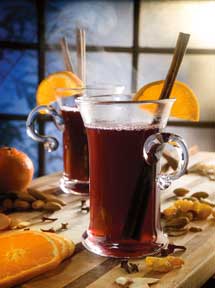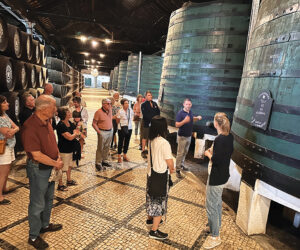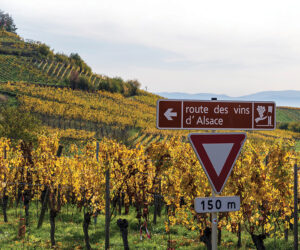
As autumn rolls into winter, the average person’s appetite for a chilled white wine, ice-cold beer or slushy blender drink wanes. A hearty red wine with deep fruit and nice tannins can be a great pleasure, but what about when it’s really cold? How about heating things up with a nice steaming hot cup of wine?
Our modern idea of hot drinks is usually divided into two categories: après-ski, for snowy winter pursuits, and after-dinner drinks — usually coffee-based, typically served with, or as, dessert. But while these drinks are all well and good, they sell the potential of hot drinks short: wine can make a delicious hot drink for every occasion or personal taste. In addition, some of them have long traditions and amusing and delightful histories that can make great stories around the fireplace.
One thing to keep in mind about hot drinks is that they’re really at their best while steaming hot. The temptation can be to consume them a bit more quickly than usual, and perhaps have another to follow. As such, it pays to keep an eye on how many glasses (or mugs) you’re consuming — relaxing in front of the fire is different from falling asleep beside it!
Hot Drinks in History
Hot drinks are not a recent innovation in Western society. In reality, cold drinks are the newcomer, with hot drinks the relative norm up until the mid-19th Century and the advent of refrigeration technology. With the majority of North America’s original immigrants hailing from Europe and Great Britain, they brought with them their recipes for chasing away the chilly, rainy climates at home.
Because central heating is another relative newcomer, every pub and tavern used to have a fireplace with a large hearth, where customers could gather and warm themselves. Often these were the center of the community, with the mail delivered there, community meetings held there and justice dispensed by travelling magistrates that would set up court in taverns on a regular schedule. (Barkeep! Another round of justice!)
Inevitably, propped in the fire were a number of poker-like irons, or loggerheads. These were used to heat up drinks served by the publican. They were dipped, red-hot from the fire, into the customers’ drink right at the table, not only heating them, but frothing them with a vigorous boil! In addition to this frothing action, any sugars in the drink would be partially caramelized by the red-hot iron, resulting in a pleasant, toffee-like character in the drink. (A funny aside: our phrase, “at loggerheads,” meaning to have an insoluble argument turn aggressive, has to do with arguments in pubs. Customers wrangling important or contentious issues over a few hot drinks sometimes took advantage of the length, solidity and weight of the loggerhead irons to make more pointed comments to their fellows. Modern establishments usually avoid leaving a supply of blunt instruments around — much less red-hot pokers!)
Even folks not conversant with the history of beverage consumption will have seen hot drinks mentioned in period books and movies. Almost everyone recalls the classic Alistair Sim version of “A Christmas Carol.” In it we see two instances of hot drinks: first, the Cratchit family has a toast at dinner with hot gin punch — including minors like Tiny Tim. The Victorians didn’t think it out of order for youth to have a bit of beverage alcohol, as startling as it is for our modern eyes to see an eight-year old toasting with a steaming glass of gin!
Second, when Scrooge finishes teasing Bob Cratchit with his raise and sends him out to buy a new coal scuttle, he mentions they’ll talk about his future over a “smoking bowl of Bishop.” They weren’t about to render an unlucky churchman for his steaming fluids, but rather going to enjoy a mug of rich, spiced red wine. Given the chill of wintertime London, it’s no surprise they wanted a hot drink!
Not Wine
Non-wine hot drinks can roughly be divided into coffee drinks, toddies and nogs, and mulled cider.
Coffee drinks have wide acceptance everywhere, and justly so: there’s nothing like a warming Irish coffee — a combination of hot coffee, Irish whisky and whipped cream — to thaw a chilled snow denizen. But other coffee drinks featuring different whiskies, rums or brandies appeal as well.
Toddies are mixtures of spices, honey (or sugar) and spirits, warmed with boiling water. The classic is brandy or whiskey with a lemon slice, a cinnamon stick and honey, and is deemed good for a sore throat. Hot buttered rum is enhanced by a pat of butter, and cutting-edge bars and restaurants are even using top-shelf tequila with a bit of honey and a lime slice for avant-garde hot drink customers.
Nog used to refer to a drink made from strong ale and eggs, frothed and heated with a loggerhead. Not many people want an egg in their suds these days, so commonly egg nog is a mixture of eggs, rum, cream, sugar and nutmeg. It’s usually served cold, but it doesn’t have to be: hot egg nog is a richly satisfying drink. Pre-packaged egg nog is available in season, so you don’t have to make your own. Even vegans and the lactose intolerant can get in on the act with soy or rice-based milk substitutes.
Another winter alternative is mulled cider, or mulled apple juice: brown sugar, cinnamon, orange and rum come together to make a smell reminiscent of hot apple pie, a wonderfully appetizing aroma when the frost is on the leaves.
And beer lovers needn’t despair: Unibroue — a Quebec brewery that specializes in wonderful Belgian-style beers — makes a spiced cherry beer called Quelque Chose. When heated, as the brewery suggests, it smells like a cherry pie, tart and sweet at the same time — a hot beer drink that pleases even people who don’t normally care for beer.
Wine-based hot drinks include Glögg, Glühwein, negus, posset, bishop and other ancient steamers.
Glögg Around the Clock
Glögg (pronounced ‘gloog’) is the Scandinavian word for mulled wine, and is derived from the German word, glühwein (“Glow-Wine”). Made from sugar, cinnamon, water, orange and cloves simmered together in wine, it’s very popular with European ski fans. Not only is it warming and restorative, it can be made to a moderate alcohol content — a good thing for the active crowd. And you needn’t break the bank on the wine used: any sturdy, fruity red works well. Keep in mind though, that the wine you choose should be pleasant and fruity to start with: trying to get rid of a flawed batch or an unfortunate bottle by covering up the taste with spices and sugar doesn’t really work very well.
There are as many Glögg recipes as there are Scandinavians: the following is for the super-charged version that makes the Swedes the happiest people on earth — Julglögg!
Glögg
1.5 L bottle of dry red wine
1.5 L bottle of port
500 mL bottle of aquavit (Swedish distilled spirit flavored with caraway)
10 in. (25 cm) of stick cinnamon
1 tbsp. cardamom seeds
2 dozen whole cloves
peel of one orange
1⁄2 cup raisins
1 cup blanched almonds
2 cups sugar
orange peel (for garnish)
Pour the red wine and port into a covered stainless steel or porcelain kettle. Add the cinnamon, cardamom, cloves, orange peel, raisins and almonds. Warm gently, but do not boil.
Put the sugar in a pan and soak it with half the bottle of brandy. Warm the sugar and brandy slurry over a low flame. The sugar will melt and bubble until it becomes a clear golden syrup of caramelized sugar. Caramelization is essential to the finished flavor.
Add the caramelized sugar to the spiced wine mix. Cover and let it mull for an hour. Just before serving, strain to remove the spices, add brandy to taste and serve it in a mug with a twist of orange peel.
Glühwein ist Gut, Ja!
Glühwein is a staple at wintertime German festivities, with vendors selling steaming mugs to shivery skaters and festival-goers. Usually a bottle of German red wine is used, but that can be hard to obtain in North America. (Germany actually makes a significant amount of red wine, but they seem to drink it all themselves.) Good choices might be Lemberger or a fruity Pinot Noir. This recipe is fast, easy, and keeps well in a thermos or crock-pot, for hours — not that it usually lasts that long on cool days!
Glühwein
1⁄2 cup water
1⁄2 cup sugar
2 whole cloves
2 cinnamon sticks
1 orange
1 bottle of red table wine (Merlot, Shiraz or other
flavorful variety)
Mix water, sugar, cinnamon, cloves and the juice of the orange together in a heavy pot. Bring up to heat, but do not boil. Add the orange peel and simmer for 15 minutes. Serve immediately in pre-heated mugs. This mixture can be kept warm in a crock-pot, or on a coffee warmer (covered) for several hours, and can be successfully reheated the next day.
(A bartender’s tip on perfect hot drinks: one thing that separates regular hot drinks from spectacular ones is heat: a shot of room-temperature alcohol and a cold mug can drop the mixture by as much as 15 °F (~8 °C) from serving temperature, making even delicious drinks seem weak or stale. Good mixologists know this, and pre-heat their mugs with boiling water, or a blast from the steam frother on the espresso machine.)
Name That Negus
Negus is a variation on the theme of spiced and heated wine. Sharing a name with the Amharic word for governor in Ethiopia, it was actually named after Francis Negus, an officer of the British Royal Court in the 1700’s, who mixed a mean batch, apparently. As he was Master of the Hounds for the court, he may have needed a drink at the end of a day of hunting. Looking at the recipe, however, one suspects he might have simply been clearing the dregs out of the drinks cupboard at the end of the night!
Negus
2 oz. LBV port
1 oz. claret
1 oz. sparkling Burgundy wine
1 tsp. brandy
2 oz. water
1⁄2 lemon
1 pinch nutmeg
1 tsp. sugar
Slice the lemon thinly, add all ingredients and bring to a simmer. Serve immediately in sturdy heat-proof cups.
Playing Posset
“. . . my wife and I, it being a great frost, went to Mrs. Jem’s, in expectation to eat a sack-posset . . .”—Samuel Pepy’s diary, January 5th, 1660
Posset is the name for a drink made with milk, curdled with strong ale or wine, and usually spiced. It was often made with sack, a fortified white wine from Spain or the Canary Islands. Sack was immensely popular in the 16th and 17th Centuries. Sir John Falstaff praised it extensively in Shakespeare’s Henry IV and it would probably mostly resemble bargain-price sweet sherry to modern tastes.
In its usual form, it was a bit more like a boozy pudding than a hot wine cocktail, with a crusty milk topping, a custard-y middle, and a jolt of rich wine on the bottom. It was given to people with colds, and prescribed as a sleeping aid — possibly where we get our ideas about a glass of warm milk before bed!
While it may seem like simple heated egg-nog, posset recipes could be very complex, with many ingredients and serving rituals. One famous recipe, from 17th Century English courtier and alchemist Sir Kenelm Digby includes the following:
“Take a pottle of Cream, and boil in it a little whole Cinnamon, and three or four flakes of Mace. To this proportion of Cream put in eighteen yolks of eggs, and eight of the whites; a pint of sack; beat your eggs very well, and then mingle them with your sack. Put in three quarters of a pound of Sugar into the Wine and Eggs, with a Nutmeg grated, and a little beaten Cinnamon; set the Bason on the fire with the Wine and Eggs, and let it be hot. Then put in the Cream boiling from the fire, pour it on high, but stir it not; cover it with a dish, and when it is settlede, strew on the top a little fine Sugar mingled with three grains of Ambergreece, and one grain of Musk, and serve it up.” — Sir Kenelm Digby, The Closet (London: 1671)
Ambergreece is a wonderfully English spelling of Ambergris, which, along with the musk would have added a very special flavor — being a sort of digestive excretion of queasy whales. Maybe we should look at the good father.
Smokin’ Bishop
“. . . we will discuss your affairs this very afternoon, over a Christmas bowl of smoking bishop, Bob.” — Charles Dickens, A Christmas Carol
Bishop was a popular drink usually made with Burgundy or Port, orange and spices, served up in a large bowl. The name is derived from the use of red wine: the robes of a bishop are traditionally a rich purple color. While this seems pretty much like a heated-up version of Sangria, it’s a bit more complex than just a pleasant, fruity-quenching drink, requiring the oranges to be cooked and slightly caramelized before steeping in the wine.
In his book, “Drinking with Dickens,” Cedric Dickens, the great-Grandson of Charles, provides recipes for and background on many of the Victorian cocktails mentioned in his grandfather’s work. Generally, the recipe follows the same route: cooked oranges, cloves, strong red wine, sugar and Port:
Smoking Bishop
5 unpeeled sweet oranges
1 unpeeled grapefruit
36 cloves
1⁄4 pound of sugar
2 bottles of red wine (strong)
1 bottle of Port
Wash the fruit and bake them in the oven until they are brownish, turning once. Remove the fruit from the oven and place into a warmed earthenware bowl. Prick six cloves into each orange. Add the sugar and pour in the red wine — do not add the Port at this time. Cover and leave in a warm place for a day or overnight. Squeeze the fruit into the wine and strain out any pulp or pips. Add the Port and bring up to heat. Be careful not to boil the mixture! Serve “smoking hot” in sturdy glasses.
Mulling It All Over
A basic mulled wine can be made simply from a bottle of red, a sliced orange, a couple of cloves and a cinnamon stick. It can also be punched up a bit, with the substitution of Cointreau for the orange or Port wine for regular red wine. Another winter alternative is mulled cider, or mulled apple juice: brown sugar, cinnamon, orange and rum come together to make a smell reminiscent of hot apple pie, a wonderfully appetizing aroma when the frost is on the leaves.
Drinking wonderfully spiced hot wine is a heritage that many modern wine drinkers aren’t aware of, but it can make a wonderful addition to your winter table, brightening the hearts of everyone. Every year at Christmas time my wife and I gather up the cats to watch the Alistair Sim “Christmas Carol” with glasses of smoking bishop in hand. We know the words by heart, so it’s almost a sing-along version, and we toast Tiny Tim and everyone else braving the cold winter and Scrooge in particular, for completing a great journey.
Philosophers distinguish three types of pleasure: sensory, cognitive and emotional. The first is the engagement of our smell and taste to sense and recognize the character of our wine. The second is the intellectual evaluation of those qualities as they please us. Philosophers contend, however, that there is no place for emotional pleasure in wine. I disagree: in the company of friends and loved ones, the connection your wine brings to those who have gone before you, and maybe those who will come after is a wonderful thing to contemplate, and I can’t think of a better drink to do it with than a steaming, spiced cup of wine.







